Capsicum annuum
Capsicum annuum is a species of the plant genus Capsicum native to southern North America, the Caribbean, and northern South America.[2][5] This species is the most common and extensively cultivated of the five domesticated capsicums. The species encompasses a wide variety of shapes and sizes of peppers, including sweet bell peppers and some chili pepper varieties such as jalapeños, New Mexico chile, and cayenne peppers, all of which are nightshades. Cultivars descended from the wild American bird pepper are still found in warmer regions of the Americas.[6] In the past, some woody forms of this species have been called C. frutescens, but the features that were used to distinguish those forms appear in many populations of C. annuum and are not consistently recognizable features in C. frutescens species.[7]
| Capsicum annuum | |
|---|---|
 | |
| Scientific classification | |
| Kingdom: | Plantae |
| Clade: | Tracheophytes |
| Clade: | Angiosperms |
| Clade: | Eudicots |
| Clade: | Asterids |
| Order: | Solanales |
| Family: | Solanaceae |
| Genus: | Capsicum |
| Species: | C. annuum |
| Binomial name | |
| Capsicum annuum | |
| Varieties and Groups | |
| |
| Synonyms[4] | |
| |
Characteristics
Capsicum annuum is a herb or small shrub growing to a height between 0.3 to 1.2 metres (1–4 feet) and a width of 15 to 30 cm (6–12 inches). It has roughly oval glossy leaves with smooth margins reaching up to 7.5 cm (3 inches) in length. In some cultivars leaves turn dark purple or black.[8]
Flowers are star or bell-shaped with 4–5 petals which can be white, green, or purple in colour. Its fruit is a true berry coming in a variety of shapes, sizes, pungency, and sweetness. Depending on cultivar, fruit may be green, red, yellow, orange, or black, with many changing colour as they mature.[9]
Pollination
While generally self-pollinating, insect visitation is known to increase the fruit size and speed of ripening, as well as to ensure symmetrical development. Pepper flowers have nectaries at the base of the corolla, which helps to attract pollinators. The anthers do not release pollen except via buzz pollination, such as provided by bumble bees.[10]
Name
The genus name Capsicum derives from a Greek-based derivative of the Latin word ‘kapto’, meaning ‘to bite’, in reference to the heat or pungency of the species’ fruit, although it has also been speculated to derive from the Latin word ‘capsa’, a box, referring to the shape of the fruit in forms of the typical species.[11] Although the species name annuum means 'annual' (from the Latin annus "year"), the plant is not an annual but is frost tender.[12] In the absence of winter frosts it can survive several seasons and grow into a large, shrubby perennial herb.[13]
Common names including the word "pepper" stem from a misconception on the part of Europeans taking part in the Columbian exchange. They mistakingly thought the spicy fruits were a variety of the black pepper plant which also has spicy fruit. However, these two plants are not closely related.[14]
Commonly used names for the fruit of Capsicum annuum in English varies by location and cultivar. The larger, sweeter cultivars are called "capsicum" in Australia and New Zealand.[15] In Great Britain and Ireland cultivars of the plant are typically discussed in groups of either “sweet” or “hot/chilli” peppers, only rarely providing the specific cultivar.[16] In Canada or the US it is commonplace to provide the cultivar in most instances, for example "bell", "jalapeño", "cayenne", or "bird's eye" peppers, to convey differences in taste including sweetness or pungency.[17]
Domestication
In 2014, based on linguistic, ecological, archaeological and genetic evidence, scientists traced origins of chili pepper (Capsicum annuum) to central-east Mexico. This domestication was dated to more than 6,500 years ago (4,500 BC).[18][19]
While the genetic evidence seems to point to northeastern Mexico as the area of domestication, evidence from some other related lines of study rather supports the central-east region of Mexico as the domestication centre. This is the area extending from the southern part of Puebla state of Mexico, to northern Oaxaca state, and to southeastern Veracruz state.[20]
Uses
Culinary

The species is a source of popular sweet peppers and hot chilis with numerous varieties cultivated all around the world, and is the source of popular spices such as cayenne, chili, and paprika powders, as well as pimiento (pimento).
Capsinoid chemicals provide the distinctive tastes in C. annuum variants. In particular, capsaicin creates a burning sensation ("hotness"), which in extreme cases can last for several hours after ingestion. A measurement called the Scoville scale has been created to describe the hotness of peppers and other foods.
Traditional medicine
Hot peppers are used in traditional medicine as well as food in Africa.[21] English botanist John Lindley described C. annuum in his 1838 Flora Medica thus:[22]
It is employed in medicine, in combination with Cinchona in intermittent and lethargic affections, and also in atonic gout, dyspepsia accompanied by flatulence, tympanitis, paralysis etc. Its most valuable application appears however to be in cynanche maligna (acute diphtheria) and scarlatina maligna (malignant Scarlet fever, used either as a gargle or administered internally.)
In Ayurveda, C. annuum is classified as follows:
- Guna (properties) – ruksha (dry), laghu (light) and tikshna (sharp)
- Rasa (taste) – katu (pungent)
- Virya (potency) – ushna (hot)
Ornamental
Some cultivars grown specifically for their aesthetic value include the U.S. National Arboretum's 'Black Pearl'[23] and the 'Bolivian Rainbow'. Ornamental varieties tend to have unusually colored fruit and foliage with colors such as black and purple being notable. All are edible, and most (like 'Royal Black') are hot. Certain cultivars of the New Mexico Chile are commonly dried in ornamental arrangements known as Ristras.
Pests
The potato tuber moth (Phthorimaea operculella) is an oligophagous insect that prefers to feed on plants of the family Solanaceae such as pepper plants. Female P. operculella use the leaves to lay their eggs, and the hatched larvae eat away at the mesophyll of the leaf.
Gallery
 Capsicum annuum L var. fasciculatum Irish.
Capsicum annuum L var. fasciculatum Irish.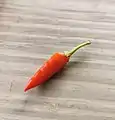 Capsicum annuum L. var. fasciculatum Irish.
Capsicum annuum L. var. fasciculatum Irish.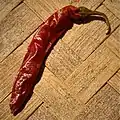 Dried Capsicum annuum Red chili pepper
Dried Capsicum annuum Red chili pepper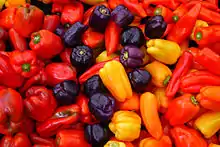 Capsicum annuum cultivars
Capsicum annuum cultivars_-_dried.jpg.webp) Dried Guajillo chile pod
Dried Guajillo chile pod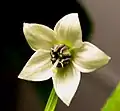 Typical Capsicum annuum flower, Royal Embers.
Typical Capsicum annuum flower, Royal Embers. Bolivian Rainbow with its fruits in different stages of ripeness.
Bolivian Rainbow with its fruits in different stages of ripeness. Capsicum annuum var. bola or ñora
Capsicum annuum var. bola or ñora Capsicum annuum Count Dracula
Capsicum annuum Count Dracula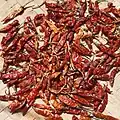 Dried Capsicum annuum Red chili pepper on Nanglo
Dried Capsicum annuum Red chili pepper on Nanglo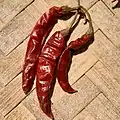 Dried Capsicum annuum Red chili pepper
Dried Capsicum annuum Red chili pepper NuMex Memorial Day
NuMex Memorial Day Capsicum annuum Explosive Embers
Capsicum annuum Explosive Embers Chili pepper 'subicho' seeds for planting
Chili pepper 'subicho' seeds for planting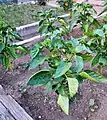 Bell pepper in Eastern Siberia
Bell pepper in Eastern Siberia
References
- Aguilar-Meléndez, A., Azurdia, C., Cerén-López, J., Menjívar, J. & Contreras, A. 2020. Capsicum annuum (amended version of 2019 assessment). The IUCN Red List of Threatened Species 2020: e.T100895534A172969027. https://dx.doi.org/10.2305/IUCN.UK.2020-2.RLTS.T100895534A172969027.en. Downloaded on 11 October 2021.
- "Capsicum annuum". Germplasm Resources Information Network. Agricultural Research Service, United States Department of Agriculture. Retrieved 2010-07-29.
- Minguez Mosquera M. I., Hornero Mendez D. (1994). "Comparative study of the effect of paprika processing on the carotenoids in peppers (Capsicum annuum) of the Bola and Agridulce varieties". Journal of Agricultural and Food Chemistry. 42 (7): 1555–1560. doi:10.1021/jf00043a031.
- "The Plant List".
- Latham, Elizabeth (2009-02-03). "The colourful world of chillies". Stuff.co.nz. Retrieved 2009-03-08.
- Francis, John K. (2003-09-09). "Capsicum annuum L. bird pepper - USDA Forest Service" (PDF). Retrieved 2013-09-30.
- Zhi-Yun Zhang, Anmin Lu & William G. D'Arcy. "Capsicum annuum Linnaeus, Sp. Pl. 1: 188. 1753". Flora of China. Vol. 17. p. 313.
- "Capsicum annuum | Description, Uses, Varieties, Family, & Facts | Britannica".
- "Capsicum annuum | Description, Uses, Varieties, Family, & Facts | Britannica".
- Capsicum pollination
- "Capsicum annuum (bell pepper)". Cabi Compendium. CABI Compendium. 2022. doi:10.1079/cabicompendium.15784. S2CID 253616052.
- "Peppers and chillies". Royal Horticultural Society. Retrieved 21 Dec 2017.
- Katzer, Gernot (May 27, 2008). "Paprika (Capsicum annuum L.)". Retrieved December 1, 2012.
- "Capsicum annuum - Britannica Encyclopedia". Britannica. 28 May 2023.
- "Expat baffled by common Aussie supermarket item". news.com.au.
- OxfordDictionaries.com, s.v.
- "Bell and Chili Peppers". Agricultural Marketing Resource Center, US Department of Agriculture. 22 May 2023. Retrieved 1 October 2021.
- (2014) Scientists Trace Origins of Domesticated Chili Pepper to Central-East Mexico. sci.news
- Kraig H. Kraft et al. Multiple lines of evidence for the origin of domesticated chili pepper, Capsicum annuum, in Mexico. PNAS, published online April 21, 2014; doi:10.1073/pnas.1308933111
- (2014) Scientists Trace Origins of Domesticated Chili Pepper to Central-East Mexico. sci.news
- Grubben, G.J.H. & Denton, O.A. (2004) Plant Resources of Tropical Africa 2. Vegetables. PROTA Foundation, Wageningen; Backhuys, Leiden; CTA, Wageningen.
- Lindley, John (1838). Flora Medica, page 509.
- "Capsicum annuum "Black Pearl"" (PDF). U.S. National Arboretum. March 2006. Retrieved February 21, 2011.
Further reading
- Malgorzata, Materska (March 2015). "Flavone C-glycosides from Capsicum annuum L.: relationships between antioxidant activity and lipophilicity". European Food Research and Technology. 240 (3): 549–557. doi:10.1007/s00217-014-2353-2.
- Arimboor, Ranjith; Natarajan, Ramesh Babu; Menon, K. Ramakrishna; Chandrasekhar, Lekshmi. P; Moorkoth, Vidya (March 2015). "Red pepper (Capsicum annuum) carotenoids as a source of natural food colors: analysis and stability-a review". Journal of Food Science and Technology. 52 (3): 1258–1271. doi:10.1007/s13197-014-1260-7. PMC 4348314. PMID 25745195.
External links
- Capsicum annuum in the CalPhotos photo database, University of California, Berkeley
- "Capsicum annuum". Calflora. Berkeley, California: The Calflora Database.
- "Capsicum annuum". Plants for a Future.

